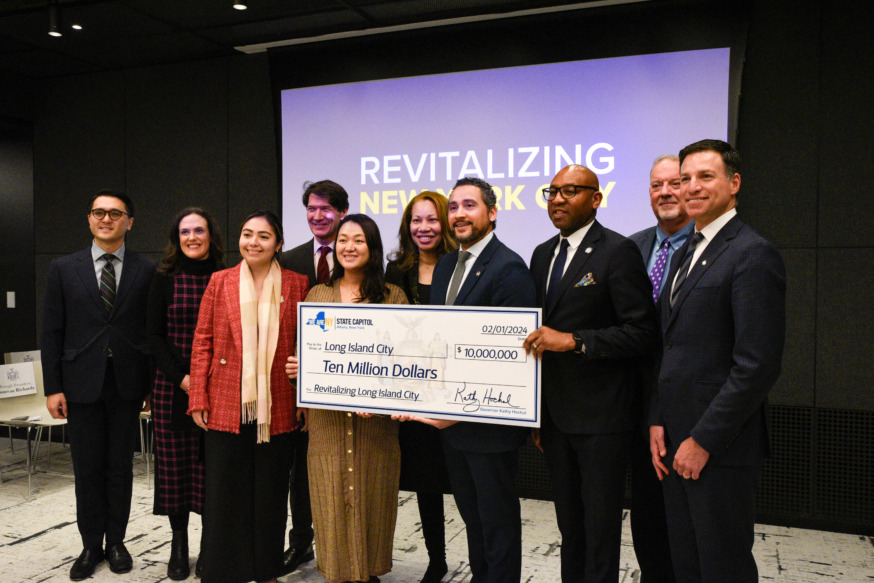
After the state awarded Long Island City with $10 million in revitalization funds, the committee selection process is now underway. Photo by Iryna Shkurhan
Mar. 19, 2024 By Iryna Shkurhan
The selection process for the committee that will decide how the $10 million in revitalization funds awarded to Long Island City by the state is currently underway.
In an attempt to ensure that the community is properly represented, members of Queens Community Board 2 sent a letter to the president of the Long Island City Partnership outlining their vision for the committee. They requested equitable representation on the committee to ensure that the needs of all LIC residents are considered and “not just private interests.”
“We are a neighborhood of innovation. The entire country has been looking at LIC as a model for a reason. This is an opportunity to be a model to really show the country and the state how comprehensive community led planning can work,” said Karesia Batan, Chair of the Arts and Culture committee on CB 2. “Our main concern is just making sure that the people who are on this committee are people who actually are very connected and tapped into our neighborhood.”
In February, Long Island City and Hudson Square in Manhattan were announced to be the part of the 7th round of recipients for the Downtown Revitalization Initiative, a major aspect of the state’s economic development program. Communities are selected based on their potential for transformation. Jamaica was selected in the very first round in 2016 and has since made improvements to pedestrian safety infrastructure.
“We felt we had to move quickly, to at least make sure that we were part of the conversation,” said Batan. “We’re charged with the responsibility to make sure all aspects of our community and our neighbors are represented. But we also know that we are advisory. So whenever projects come in, and they’re moving quickly, it’s very easy for us to be brushed over.”
One crucial aspect of their request was to see the arts and culture sector, which reflects the rich history of the neighborhood, not be sidelined as it has historically. They also wanted to ensure that 85% of the board is made up of LIC residents that represent the local community.
“Because Long Island City has such a rich history, and population of artists, and cultural workers, I also wanted to make sure that that was going to be thought of throughout the revitalization alongside all the other concerns,” said Batan.
The number of committee seats available has not been disclosed, but in its request the board assumed 20 seats. The board requested one seat for community board 1 and 2, three seats for small business owners and two seats for homeowners, among other distributions. The Long Island City Partnership (LICP), which submitted the application to the state for the revitalization funds, has a designated seat.
Laura Rothrock, the president of LICP, says that she’s on the same page as the community board in hoping to see a diverse range of sectors represented on the committee. But despite the letter being addressed to her, the LICP does not have a say in the formation of the committee.
“If all of those different populations are represented, then that would make for a diverse planning committee that would all bring different perspectives, but hopefully be able to come towards a similar goal,” said Rothrock. “I made the commitment to them [CB 2] that I would advocate for their representation, including arts and culture.”
The state hires an independent consultant to oversee the program and administer the committee, and in the case of NYC, the Queens Borough President compiles a committee list made up of a dozen or so members. The state then has final approval, over both the committee, and the projects that will receive funding.
The first step of the committee, once formed and announced, is to create a strategic plan for the funding. After that is in place, there will be a call for projects from local residents to submit their own ideas for how funds should be used.
The proposals need to have a source of matching funds tied to them and a timeline of under 5 years. They must also tie into the strategic vision crafted by the committee. In the case of Jamaica, $2.5 million of the $10 million from the state was used for the sidewalk improvements and pedestrian islands, with matching funds from the city’s Department of Transportation and Department of Design and Construction.
During a community event at Long Island City’s Culture Lab in September, 186 community members in attendance responded to “How would you spend $10M for LIC?” The majority said that supporting small businesses was a priority; improving infrastructure came in second; and beautifying the streetscape came in third.
The community board chairs noted that they represent sectors of the community, not individuals, hence their desire to see industries such as education, arts, healthcare and the environment represented in the committee.
At a recent Community Board 2 meeting, where the Queens Borough President Donovan Richards was in attendance, board members asked him about the formation of the committee.
“We’re pitching a list of folks from different diverse backgrounds, everyone from public housing to arts to small business, to Blissville. So, we want to make sure that any organizations or people who historically haven’t been at the table, have an opportunity to be at this table.”
Richards noted that he “wanted it to feel more community heavy rather than developer heavy” at a recent Community Board 2 meeting.
“I don’t believe there should be any challenge to achieve what we’re requesting. And I believe it’s very fair and reasonable,” said Anatole Ashraf, the chair of CB 2. “There’s got to be holistic representation.”






